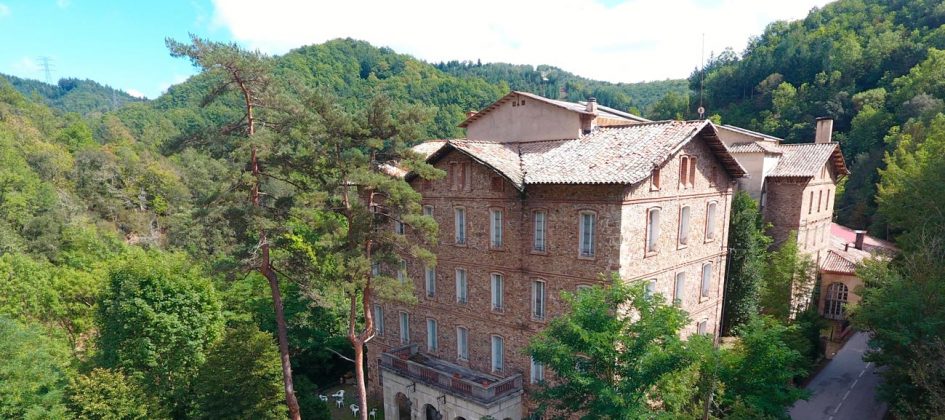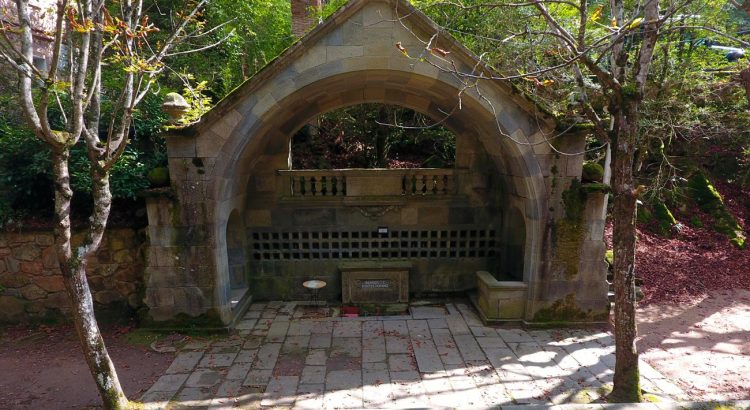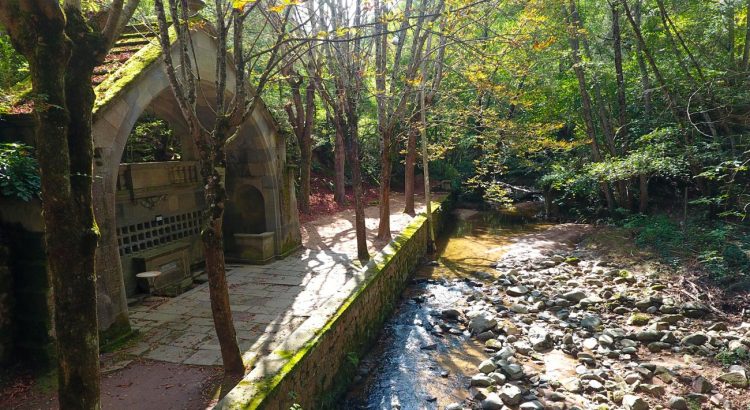Former spa of Font Picant
The former spa of Font Picant is situated about 4km from the centre of the town, on the Osor road. It was one of the most famous spas in Spain at the beginning of the 20th century, as it was known for its mineral-medicinal waters. Over the time, it became a summer resort and a meeting point for the Catalan bourgeoisie.

In order to understand the importance of this place, it is necessary to understand the history and the significance of the discovery of the mineral-medicinal water in Sant Hilari, which was a turning point for the growth of the town.
For this reason, we can talk about two Sant Hilari: the rural town lost among the mountains, where the people worked growing potatoes or in relevant trades such the ones with the wood or in the forest; and the tourist and health destination of the upper-middle class who came here to rest and for the cures.
HISTORY
The water of Font Picant was discovered at the end of the 16th century. It is said that some farmers with cows and oxen saw their animals drank from the water hidden in the vegetation. Those farmers tasted the water and discovered it has a different flavour. After drinking it, they realised they had to urinate more often and they were hungrier. However, they realised the water had special properties when an ox, probably because of the summer heat, had an irritation in its kidneys (it urinated blood as it is popularly known). The farmers saw it drinking water from that spring everyday, along with the rest of the herd, and that every day its urine was clearer until it completely healed, recovering all its agility. This peculiarity was discussed in town, until Dr. Gravalosa, the doctor in Sant Hilari, found it out. He tasted the water himself and found that it had good diuretic properties. He began prescribing it to his patients with bladder problems, nephritic colics and kidney problems, and observed that all of them got better.
From then on, Doctor Gravalosa made it published and wrote the first report about this water in 1779. It describes the properties which help to cure nephritic colics and kidney diseases. It also includes the first analyses carried out. Over the years, people from other countries started coming and the town became important for its therapeutic water.
In the 18th century, both the population and the houses in Sant Hilari doubled in number. However, the economic growth started in the late 19th and in the early 20th.
At the beginning of the 19th century, many people came to Hostalric by train and from there to Arbúcies by transport. A lot of them stayed there and made some people bring the water from Sant Hilari, since the communication was very complicated. In 1877, a road was open: first in connection with Vic and then with Arbúcies and therefore, people already used it to get to Sant Hilari.
During the 19th century, between 1,400 and 1,600 people visited Font Picant every year. In those days, the springs were quite neglected considering their reputation. The Governor of Girona, after visiting them in 1846, ordered the town council to meet the owner in order to fix the area.
Many famous people visited or drank the water from Font Picant. For example, the king Ferdinand IV of Spain made it send to Madrid due to the gout.
More than once, the spa had to be closed due to conflicts such as the Spanish Civil War.
Over the years, the water was analysed and new springs with different properties were discovered. A total of five springs were found, three of which were declared for public consumption in 1879.
– Font de Sant Josep or Font Picant: the oldest and the one with the most medicinal properties. It is very rich in carbon dioxide and carbonates, so it is very suitable for all kinds of lithiasis.
– Font de Santa Escolàstica: it was discovered in 1877 and it is the most recommended for curing gastralgia and stomach diseases.
– Font de Santa Teresa: it was discover in 1877 and is the most suitable to cure diseases in the liver and cholelithiasis.
Two more springs were later discovered:
– Font de Santa Modesta: discovered in 1878, very rich in iron and used for chlorosis and anaemia.
– Font de Sant Joan: discovered in 1880, weak iron mineralisation recommended for chlorosis and anaemia.
In 1880, a building was constructed in order to offer comfort to the people who needed the water as a treatment. It was inaugurated the 15th June 1881. It consisted of a single floor which could hold very few people. Later, in 1884, the building had electricity and telephone service and in 1895 four more floors were added. Moreover, they fixed the path to cross Mansolí stream. By the end of the 19th century, the spa was already known nationally.
During the 20th century, the hotel worked so well. It consisted of four floors with 250 rooms, a restaurant, a big dining room, a chapel, a ballroom, billiards, a gallery, kitchens, bathrooms, and so on.
Unfortunately, during the Spanish Civil War, the Generalitat (the Catalan Goverment) took over the spa and it was used as a military hospital, which caused a lot of damage to the building. During the post-war, there was a great decrease of visitors.
Finally, between 1992 and 1993 it was ceded to the Generalitat for social welfare uses. They rehabilitated a lot of spaces: they restored furniture, changed rooms, and adapted spaces. Five years later, the Generalitat stopped using the building.
Today, the ground floor of the hotel is used for celebrations, parties and caterings (the same floor where there were the dining rooms). Moreover, you can visit it and you can taste three of the five springs.


